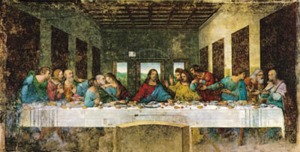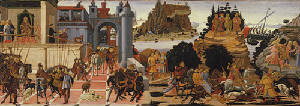 |
| Home |
| 1 Ancient Mesopotamia |
| 2 Ancient Egypt |
| Ancient Greece |
| 3 Ancient Rome |
| Judaism and Christianity |
| 4 Byzantine and Islamic Civilization |
| Indian Civilization |
| 5 Chinese civilization |
| Japanese civilization |
| Early American Civilization |
| 6 Early Ages, Romanesque, Gothic |
| Renaissance |
| 7 Baroque,18th,Romanticism, Realism |
| 8 Belle Epoque,Chinese & Japanese society |
| 9 Russian,Age of Anxiety,Africa, Latin Am. |
| 10 Age of Affluence, diversity |
|
|
 |
|


Renaissance 
Related: General Literature
| (rĕnesäns´, -zäns´)
[Fr.,=rebirth], term used to describe the development of Western civilization that marked the transition from medieval to
modern times. This article is concerned mainly with general developments and their impact in the fields of science, rhetoric,
literature, and music. |
In the 12th cent. a rediscovery of Greek and Roman literature occurred
across Europe that eventually led to the development of the humanist movement in the 14th cent. In addition to emphasizing
Greek and Latin scholarship, humanists believed that each individual had significance within society. The growth of an interest
in humanism led to the changes in the arts and sciences that form common conceptions of the Renaissance.
The 14th cent. through the 16th cent. was a period of economic flux in Europe; the most extensive changes took place in Italy.
After the death of Frederick II in 1250, emperors lost power in Italy and throughout Europe; none of Frederick's successors
equaled him. Power fell instead into the hands of various popes; after the Great Schism (1378-1415; see Schism, Great ), when three popes held power simultaneously, control returned to secular
rulers.
During the Renaissance small Italian republics developed into despotisms as the centers
of power moved from the landed estates to the cities. Europe itself slowly developed into groups of self-sufficient compartments.
At the height of the Renaissance there were five major city-states in Italy: the combined state of Naples and Sicily, the
Papal State, Florence, Milan, and Venice. Italy's economic growth is best exemplified in the development of strong banks,
most notably the Medici bank of Florence. England, France, and Spain also began to develop economically based class systems.
|
 |
|
RENAISSANCE TRADE
The Beginning of Trade
Although navigation was still an imprecise science, sailors were able to
go farther than they had before. This was important because as the economy of the Renaissance continued to improve, there
were ever-increasing demands for imported goods and new places to export local products.
 (For traders, sailing proved to be a better option than traveling by land,
as the network of roads that crisscrossed Europe was poor, and the few good roads that did exist were frequented by thieves.) (For traders, sailing proved to be a better option than traveling by land,
as the network of roads that crisscrossed Europe was poor, and the few good roads that did exist were frequented by thieves.)
The Renaissance sailor first took to the seas to supply Europeans with the
many Asian spices they demanded. Peppercorns, nutmeg, mace, and cinnamon all came from lands to the east. Also from the East
came precious gems and fine silk, a fabric especially sought after for women's clothing. These trading voyages were often
paid for by investors.
TOOLS
Tools developed in the Middle Ages for exploration continued to be used during
the Renaissance. One of these was the astrolabe, a portable device used by sailors to help them find their way. By measuring
the distance of the sun and stars above the horizon, the astrolabe helped determine latitude, an important tool in navigation.
Another tool, the magnetic compass, which had been invented in the twelfth century, was improved upon during the Renaissance.
Maps, too, became more reliable as Portuguese map makers, called cartographers,
incorporated information provided by travelers and explorers into their work. Shipbuilding also improved during the Renaissance,
as large ships called galleons became common. These ships were powered by sail rather than by men using oars.
Beginning in the latter half of the 15th cent., a humanist
faith in classical scholarship led to the search for ancient texts that would increase current scientific knowledge. Among
the works rediscovered were Galen 's physiological and anatomical studies and Ptolemy 's Geography. Botany, zoology, magic, alchemy, and astrology were developed
during the Renaissance as a result of the study of ancient texts. Scientific thinkers such as Leonardo da Vinci , Nicolaus Copernicus , Galileo , Tycho Brahe , and Johannes Kepler attempted to refine earlier thought on astronomy. Among Leonardo's discoveries
were the revelation that thrown or shot projectiles move in one curved trajectory rather than two; metallurgical techniques
that allowed him to make great sculptures; and anatomical observations that increased the accuracy of his drawings.
In 1543 Copernicus wrote De revolutionibus, a work that placed the sun at the center of the universe and the planets
in semicorrect orbital order around it; his work was an attempt to revise the earlier writings of Ptolemy. Galileo's most
famous invention was an accurate telescope through which he observed the heavens; he recorded his findings in Siderius
nuncius [starry messenger] (1610). Galileo's Dialogo … sopra i due massimi sistemi del mondo
[dialogue concerning the two chief world systems] (1632), for which he was denounced by the current pope (because of Galileo's
approval of Copernicus), resulted in his living under house arrest for
the rest of his life. Tycho Brahe gave an accurate estimate of planetary positions and refuted the Aristotelian theory that
placed the planets within crystal spheres. Kepler was the first astronomer to suggest that planetary orbits were elliptical.
Renaissance music took great liberties with musical
form. In 1300 the most popular music was French and secular. Although secular music gradually spread all over Europe, it flowered
in Italy. In fact, in about 1330 an Italian school of musical composition developed in Padua, Verona, Bologna, Florence, and
Milan. Often this music was written in the vernacular; its primary composers, thinkers such as Leonardo Giustiniani (1398-1446)
and Marsilio Ficino , would often improvise words to the accompaniment of a lute-viola. This experimentation
led to the development of contrapuntal music, or music that hinged on the pleasing interplay of two melodic lines.
Josquin Desprez composed masses, chansons, and motets, of which his Hercules Dux Ferriare
mass and Misere motet are lasting examples; he was one of the first composers to use imitation, or repetition of melodies,
successfully within a composition. Giovanni Pierluigi Palestrina also composed mainly religious music. He distinguished himself with his motets
and masses, namely Veni creator spiritus, Missa brevis, and Accepit Jesus calicem ; he also made full
use of the cantus firmus, or pre-existing melody around which other melodies are intertwined, in his compositions. Orlando
di Lasso was also a noted composer whose work included motets, chansons, and madrigals.
QUESTIONS ABOUT RENAISSANCE:
1. What is the role of Greek civilization during renaissance?
2. What are some of the scientific discoveries made during this period?
3. Give some famous painters and their works.
4. Give some famous sculptors and their works.
5. Give some famous builders and their works.
6. What is humanism?
7. What are some of the tools used during this time?
8. Why did the sailors sail around the world?
9. Why did book printing change learning?
10. why is Florence considered the model city for the renaissance period?
|
 |
|
|
|
 |
|
Humanism in Renaissance rhetoric was a reaction to Aristotelian
scholasticism, as espoused by Francis Bacon , Averroës , and Albertus Magnus , among others. While the scholastics claimed a logical connection between
word and thought, the humanists differentiated between physical utterance and intangible meditation; they gave common usage
priority over sets of logical rules.
The humanists also sought to emulate classical values. Joseph
Webbe wrote textbooks that taught Latin through reconstruction of the sentences of classical authors from individual phrases
and clauses. Roger Ascham taught that one could learn to speak effectively by studying the speeches of
ancient orators. Thomas Elyot wrote The Book Named the Governor, which suggested rules for effective
statesmanship. Thomas More 's most significant contribution to humanism was Utopia, a design for
an ideal society based primarily on works by classical authors.
The effect of humanism on English
literature was wide and far-reaching. It is evidenced, for example, in the works of Ben Jonson and William Shakespeare . The poems and plays of Jonson often center on the difference between virtue
and vice; Jonson considers sincerity, honesty, self-discipline, and concern to be chief virtues, while dissimulation, lying,
or masking of identity is vicious behavior. His Volpone and The Alchemist exemplify humanist values. In a play
such as Shakespeare's Tempest, a main character (Prospero) embodies a full range of human abilities: father, creator,
ruler, magician, master, and scholar. In addition, Shakespeare took subject matter for many plays from classical sources (e.g.,
Coriolanus, Troilus and Cressida, and Julius Caesar ).
INVENTION OF PRINTING PRESS
When Gutenberg invented the
printing press in 1445, he forever changed the lives of people in Europe and, eventually, all over the world. Previously,
bookmaking entailed copying all the words and illustrations by hand. Often the copying had been done onto parchment, animal
skin that had been scraped until it was clean, smooth, and thin. The labor that went into creating them made each book very
expensive. Because Gutenberg's press could produce books quickly and with relatively little effort, bookmaking became much
less expensive, allowing more people to buy reading material.
Humanism Emerges
Books also helped to spread awareness of a new philosophy that emerged when
Renaissance scholars known as humanists returned to the works of ancient writers. Previously, during the Middle Ages, scholars
had been guided by the teachings of the church, and people had concerned themselves with actions leading to heavenly rewards.
The writings of ancient, pagan Greece and Rome, called the "classics," had been greatly ignored. To study the classics, humanists
learned to read Greek and ancient Latin, and they sought out manuscripts that had lain undisturbed for nearly 2,000 years.
The humanists rediscovered writings on scientific matters, government, rhetoric,
philosophy, and art. They were influenced by the knowledge of these ancient civilizations and by the emphasis placed on man,
his intellect, and his life on Earth.
FLORENCE AND RENAISSANCE
The Renaissance was a rebirth that occurred throughout most of Europe. However, the changes that we associate with the
Renaissance first occurred in the Italian city of Florence and continued to be more pervasive there than anywhere else. The
city's economy and its writers, painters, architects, and philosophers all made Florence a model of Renaissance culture.
Fifteenth-century Florence was an exciting place to be. In 1425 the city had a population of 60,000 and was a self-governed,
independent city-state. Twelve artist guilds that regulated the trades were the basis of Florence's commercial success. Members
of the guilds, who were wealthy and held positions in government, were some of Florence's most influential people in society
and politics. Because of its strong economy and a political philosophy that was dedicated to the welfare of the city, Florence
thrived.
The most powerful guilds were those that represented textile workers. Much of Florence's wealth was dependent on the manufacture
or trade of cloth, primarily wool. Wool of superior quality was often purchased unfinished and untreated from England and
Iberia. Florentine textile workers then cleaned, carded, spun, dyed, and wove the wool into cloth of excellent quality. They
sold the finished material in Italy, northern European cities, and even in eastern countries. Other textile experts purchased
inferior cloth from northern cities and refinished it to create a superior product.
|
 |
|
|
|
|
|
|
|
 |

